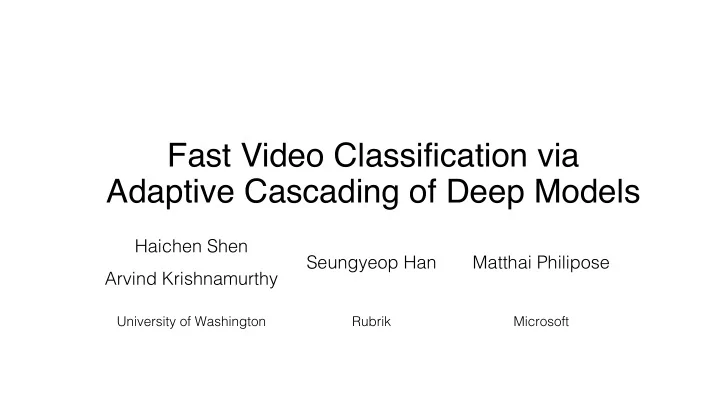

Fast Video Classification via Adaptive Cascading of Deep Models Haichen Shen Seungyeop Han Matthai Philipose Arvind Krishnamurthy University of Washington Rubrik Microsoft
Recognizing entities in every frame of videos • Convolutional neural networks (“Oracle” model) ✔ High accuracy in recognizing thousands of classes ✗ Expensive to execute • Simpler convolutional neural networks (”Compact” model) ✗ Low accuracy in recognizing thousands of classes ✔ Cheap to execute How can we reconcile this?
Object Skew in 1-minute video segments • DominantObjectCount: # of objects that account for 80% of all object occurrences in 1-minute segments 0:00 0:30 1:00 1:30 2:00 2:30 3:00 Segment 1 Segment 2 Segment 3 • Day-to-day video contains a tiny subset of classes in a short interval. 100% 80% 60% 70% of segments have 40% DominantObjectCount <= 10 20% 0% 0 10 20 30 40 DominantObjectCount
Object Skew in 1-minute video segments • DominantObjectCount: # of objects that account for 80% of all object occurrences in 1-minute segments 0:00 0:30 1:00 1:30 2:00 2:30 3:00 Segment 1 Segment 2 Segment 3 • Day-to-day video contains a tiny subset of classes in a short interval. 100% Can we exploit temporal skew in a video to 80% 60% 70% of segments have accelerate the recognition speed? 40% DominantObjectCount <= 10 20% 0% 0 10 20 30 40 DominantObjectCount
Approach: Cascade oracle model with a less expensive “compact” model dominant Compact classes all classes model Specialized “other” Oracle model model Challenges: • Can specialized models have accuracy comparable to oracle models? • Can we produce specialized models fast enough during runtime? • How to determine when to switch specialized models without any ground truth data?
Specialized models have comparable accuracy under skewed distributions Model FLOPS CPU lat. GPU lat. GoogLeNet (oracle) 3.17G 779 ms 11.0 ms Compact CNN 0.82G 218 ms 4.4 ms Object recognition (1000 classes) 100% Top-1 accuracy 80% 60% 40% 20% 0% GoogleNet Compact 5-class, 5-class, 5-class, 20-class, 20-class, 90%-skew 80%-skew 70%-skew 90%-skew 80%-skew
Producing specialized models can be fast • We pre-train the compact models on the full, unskewed datasets during development time. • At the test time, fix the lower layers and only re-train the top fully connected layer of the compact model. • Cache feature vectors of compact models for all inputs in the training datasets. Generate the specialized model ~10 seconds.
Bandit-style algorithm to determine when to switch specialized models • Oracle Bandit Problem • Exploration: use the oracle model to estimate the distribution. • Exploitation: use a specialized model to accelerate the recognition • Windowed ε -Greedy (WEG) Algorithm • Adaptively select the windows size for sampling. • Produce a specialized model when a skew is detected. • Use heuristics to detect skew changes while “exploiting” specialized models.
Evaluation oracle WEG length video (min) acc. (%) GPU lat. (ms) acc. (%) GPU lat. (ms) Friends 24 93.2 28.97 93.5 7.0 (x4.1) Good Will Hunting 14 97.6 28.84 95.1 3.7 (x7.8) Ellen Show 11 98.6 29.26 94.6 4.7 (x6.2) The Departed 9 93.9 29.18 93.5 6.9 (x4.2) Ocean’s Eleven / 6 97.9 28.97 96.0 12.3 (x2.4) Twelve
Recommend
More recommend